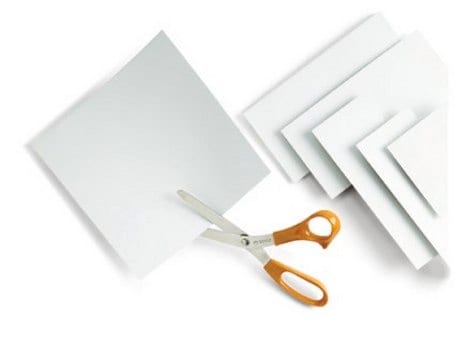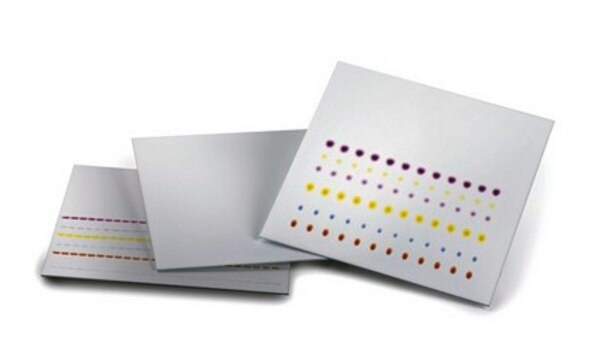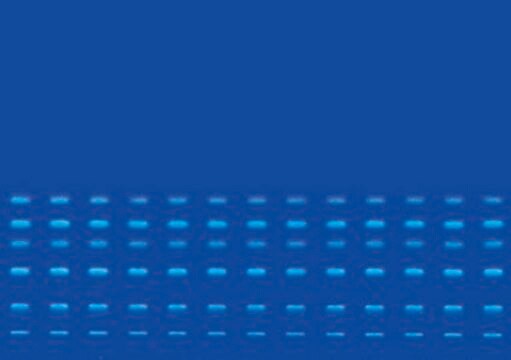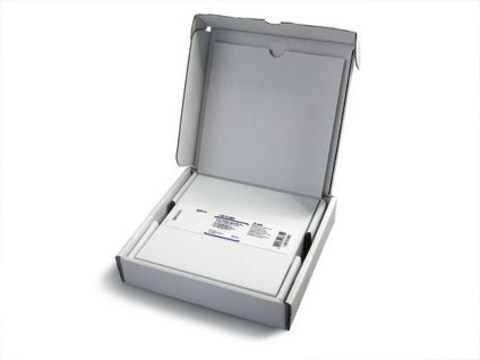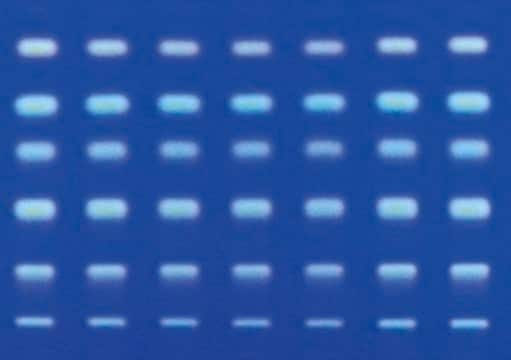1.05716
TLC plates, Cellulose
pkg of 25 plates, plate L × W 20 cm × 20 cm, glass support
Synonyme(s) :
Cellulose Thin Layer Chromatography Plates
About This Item
Produits recommandés
Matériaux
cellulose matrix
glass support
Niveau de qualité
Caractéristiques
binder Organic Polymer
fluorescent indicator: no
Conditionnement
pkg of 25 plates
Technique(s)
thin layer chromatography (TLC): suitable
Épaisseur de la couche
80-120 μm
Plaque/Plateau, L × l
20 cm × 20 cm
Température de stockage
2-30°C
Catégories apparentées
Description générale
Application
- Rapid and sensitive naked eye detection of faecal pigments using their enhanced solid-state green fluorescence on a zinc acetate substrate.: This study highlights a rapid and sensitive method for detecting fecal pigments using cellulose TLC plates and zinc acetate substrate, which enhances green fluorescence visible to the naked eye (Prakash and Mishra, 2022).
- Long-Term Fluorescence Behavior of CdSe/ZnS Quantum Dots on Various Planar Chromatographic Stationary Phases.: This research investigates the fluorescence behavior of quantum dots on cellulose TLC plates, providing insights into their long-term stability and potential analytical applications (Zarzycki, 2022).
- Investigation of Hybrid Methods for Elimination of Brilliant Blue Dye from Water Phase Using Various Nanomaterials Combined with Activated Sludge and Duckweed.: This article explores the use of nanomaterials, including cellulose TLC plates, for the effective removal of dyes from water, demonstrating their utility in environmental chemistry (Zarzycki et al., 2021).
- Low-Temperature Plasma Probe Mass Spectrometry for Analytes Separated on Thin-Layer Chromatography Plates: Direct vs Laser Assisted Desorption.: This research compares direct and laser-assisted desorption methods for analytes separated on cellulose TLC plates, highlighting advancements in mass spectrometry techniques (Gong et al., 2020).
Liaison
Remarque sur l'analyse
Deviation of layer thickness per plate: ≤ 30 µm
Aminoacid test
hRf-values
- L-serine, amino acid test:
20 - 30
- L-threonine, amino acid test: 29 - 36
- L-alanine, amino acid test: 30 - 40
- L-methionine, amino acid test: 49 - 60
- L-phenylalanine, amino acid test: 59 - 70
- L-leucine, amino acid test: 66 - 76
Typical value determined on a plate
Eluent: 1-Butanol/ acetone/ acetic acid/ water (35/35/7/23 v/v/v/v) twice developed
Code de la classe de stockage
10-13 - German Storage Class 10 to 13
Certificats d'analyse (COA)
Recherchez un Certificats d'analyse (COA) en saisissant le numéro de lot du produit. Les numéros de lot figurent sur l'étiquette du produit après les mots "Lot" ou "Batch".
Déjà en possession de ce produit ?
Retrouvez la documentation relative aux produits que vous avez récemment achetés dans la Bibliothèque de documents.
Notre équipe de scientifiques dispose d'une expérience dans tous les secteurs de la recherche, notamment en sciences de la vie, science des matériaux, synthèse chimique, chromatographie, analyse et dans de nombreux autres domaines..
Contacter notre Service technique